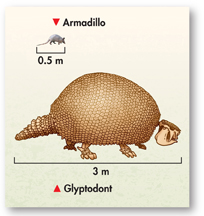 Darwin noticed that some fossils of extinct animals were similar to living species. One set of fossils unearthed by Darwin belonged to the long-extinct glyptodont, a giant armored animal. Currently living in the same area was a similar animal, the armadillo. You can see in Figure 16–3 that the armadillo appears to be a smaller version of the glyptodont. Darwin said of the organisms: “This wonderful relationship in the same continent between the dead and the living, will, I do not doubt, hereafter throw more light on the appearance of organic beings on our earth, and their disappearance from it, than any other class of facts.” So, why had glyptodonts disappeared? And why did they resemble armadillos?
Darwin noticed that some fossils of extinct animals were similar to living species. One set of fossils unearthed by Darwin belonged to the long-extinct glyptodont, a giant armored animal. Currently living in the same area was a similar animal, the armadillo. You can see in Figure 16–3 that the armadillo appears to be a smaller version of the glyptodont. Darwin said of the organisms: “This wonderful relationship in the same continent between the dead and the living, will, I do not doubt, hereafter throw more light on the appearance of organic beings on our earth, and their disappearance from it, than any other class of facts.” So, why had glyptodonts disappeared? And why did they resemble armadillos?
Putting the Pieces of the Puzzle Together On the voyage home, Darwin thought about the patterns he'd seen. The plant and animal specimens he sent to experts for identification set the scientific community buzzing. The Galápagos mockingbirds turned out to belong to three separate species found nowhere else! And the little brown birds that Darwin thought were wrens, warblers, and blackbirds were actually all species of finches! They, too, were found nowhere else, though they resembled a South American finch species. The same was true of Galápagos tortoises, marine iguanas, and many plants that Darwin collected on the islands.
Darwin was stunned by these discoveries. He began to wonder whether different Galápagos species might have evolved from South American ancestors. He spent years actively researching and filling notebooks with ideas about species and evolution. The evidence suggested that species are not fixed and that they could change by some natural process.

FIGURE 16–3 Related Organisms? Despite their obvious differences, Darwin wondered if the armadillo might be related to the ancient glyptodont. Compare and Contrast What similarities and differences do you see between these two animals?
16.1 Assessment

-
Review What is evolution?
Apply Concepts What ideas were changing in the scientific community at the time of Darwin's travels? How might those new ideas have influenced Darwin?
-
Review What three kinds of variations among organisms did Darwin observe during the voyage of the Beagle?
Infer Darwin found fossils of many organisms that did not resemble any living species. How might this finding have affected his understanding of life's diversity?
Apply the Big idea
You have learned that both biotic and abiotic factors affect ecosystems. Give some examples of each, and explain how biotic and abiotic factors could have affected the tortoises that Darwin observed on the Galápagos Islands.

Table of Contents
- Formulas and Equations
- Applying Formulas and Equations
- Mean, Median, and Mode
- Estimation
- Using Measurements in Calculations
- Effects of Measurement Errors
- Accuracy
- Precision
- Comparing Accuracy and Precision
- Significant Figures
- Calculating With Significant Figures
- Scientific Notation
- Calculating With Scientific Notation
- Dimensional Analysis
- Applying Dimensional Analysis




